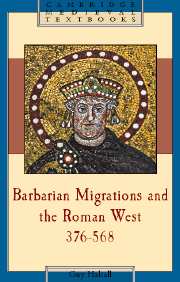Book contents
- Frontmatter
- Contents
- List of maps and figure
- Acknowledgements
- A note on spellings
- Part I Romans and barbarians in the imperial world
- Part II A world renegotiated: Western Europe, 376–550
- Part III Romans and barbarians in a post-imperial world
- 13 Mechanisms of migration and settlement
- 14 New peoples, new identities, new kingdoms?
- 15 A changed world: the roots of failure
- Appendix: Gildas' narrative and the identity of the ‘proud tyrant’
- Bibliography
- Index
- Key to map 3 on page 75
- Cambridge Medieval Textbooks
13 - Mechanisms of migration and settlement
Published online by Cambridge University Press: 05 June 2012
- Frontmatter
- Contents
- List of maps and figure
- Acknowledgements
- A note on spellings
- Part I Romans and barbarians in the imperial world
- Part II A world renegotiated: Western Europe, 376–550
- Part III Romans and barbarians in a post-imperial world
- 13 Mechanisms of migration and settlement
- 14 New peoples, new identities, new kingdoms?
- 15 A changed world: the roots of failure
- Appendix: Gildas' narrative and the identity of the ‘proud tyrant’
- Bibliography
- Index
- Key to map 3 on page 75
- Cambridge Medieval Textbooks
Summary
THE MECHANICS OF MIGRATION
The historiographical trend of recent decades has been to downplay the scale of the fifth-century migrations. Changes once explained in terms of mass migration, linked to primordialist concepts of ethnicity, are now accounted for by appeal to shifts in identity, cultural assimilation or integration. Migration has, however, always had its die-hard defenders and recently the opponents of those who minimise the scale of late antique popular movement have invoked so-called ‘migration theory’ in their defence. Migration theory comprises the results of comparative study of the mechanics of migration, generally in modern historical periods. Study of well-documented population transfer has sub-divided the phenomenon into different types of migration and has isolated a number of features that characterise and indeed determine the nature of the movement of people.
Migration may, for example, be long-distance or more local. It may be circular (or tethered), where individuals move – sometimes over considerable distances – during particular periods of a usually annual cycle before returning home. This might be to take flocks or herds to new pastures (whether transhumance is usefully classified as migration is, however, arguable) or to take advantage of seasonal labour opportunities. Migrations can also be called chain migrations, where some groups move but retain links to their kin in their homeland, and are then followed to the new land by other groups within this network, who themselves retain similar ties, and so on. There is career migration. And so on.
- Type
- Chapter
- Information
- Barbarian Migrations and the Roman West, 376–568 , pp. 417 - 454Publisher: Cambridge University PressPrint publication year: 2007



